| Palaeos |  |
Glossary |
| Plants | Glossary P-Q |
| Page Back | Unit References |
Unit Dendrogram |
Page Next | ||
Pieces |
Glossary P-Q
A B C D E F G H I J K L M N O P Q R S T U V W X Y Z
-P-
P-Type Tracheid: See tracheid types.
 Palmate: a pattern of leaf venation in which several main veins radiate in different directions from a (more or less) central point, e.g. the emblematic Canadian maple leaf. Compare pinnate, parallel-veined.
Palmate: a pattern of leaf venation in which several main veins radiate in different directions from a (more or less) central point, e.g. the emblematic Canadian maple leaf. Compare pinnate, parallel-veined.
Palynomorph: a fossil spore or pollen type.
Parallel-veined: a pattern of leaf venation in which several main veins extend through the leaf in parallel. Compare palmate, pinnate.
Paraphyletic: a taxon is said to be paraphyletic if it does not contain all descendants of its last common ancestor. So, for example, "seedless plants" is paraphyletic because its last common ancestor would also be the ancestor of plants with seeds. A clade must contain all descendants of its last common ancestor. It is usually fairly important to stick to a consideration of clades. However, that importance can often be outweighed by the utility of being able to discuss the earliest forms of some group. We normally signal that we are talking about such a paraphyletic group by saying "basal seedless plants" or "paraphyletic seedless plants" or by the use of some other, similar linguistic artifice.
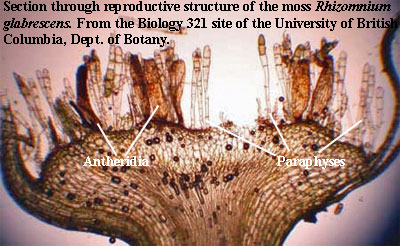 Paraphysis: "Paraphyses are sterile, multicellular, generally uniseriate [a single row of cells], chlorophyllous hairs found among the gametangia of most mosses ... ." Kenrick
& Crane (1997).
Paraphysis: "Paraphyses are sterile, multicellular, generally uniseriate [a single row of cells], chlorophyllous hairs found among the gametangia of most mosses ... ." Kenrick
& Crane (1997).
Parenchyma: the most common type of plant cell; thin-walled cells varying in size, shape, and function. Parenchyma cells are usually loosely packed cubed-shaped or elongated cells that contain a large central vacuole and have thin, flexible cell walls. Parenchymal cell walls are enriched in pectins and therefore stain pink with Toluidine Blue. They also have simple pits. Parenchymal cells are found in large numbers in the pith and cortex. They are the least specialized cells in the plant and normally act as a sort of reserve of stem cells. They may also serve a number of functions, including food storage (either water or nutrients), photosynthesis, as well as tissue repair. Compare cholenchyma, sclerenchyma.
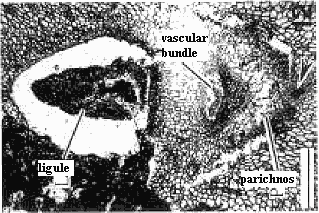 Parichnos: an interconnected system of parenchymous strands with many air spaces that extend throughout the vegetative organs of some arborescent lycopsids. Essentially, parichnos tissue is parenchyma with lots of air space between cells. This tissue probably aided photosynthetic gas exchange in much the same way as do the lenticels of modern trees. Image: oblique section through a leaf base of "Lepidodendron" from Zhou et al. (2004). Scale bar = 500µ.
Parichnos: an interconnected system of parenchymous strands with many air spaces that extend throughout the vegetative organs of some arborescent lycopsids. Essentially, parichnos tissue is parenchyma with lots of air space between cells. This tissue probably aided photosynthetic gas exchange in much the same way as do the lenticels of modern trees. Image: oblique section through a leaf base of "Lepidodendron" from Zhou et al. (2004). Scale bar = 500µ.
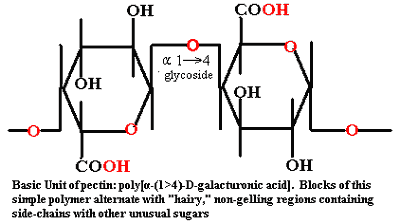 Pectin: yet another sugar polymer. In plants, pectin occurs on cell walls of parenchyma and related cell types where it apparently strengthens the cell wall and assists in cell-to-cell adhesion. It is frequently extracted and used as a thickener for preserves.
Pectin: yet another sugar polymer. In plants, pectin occurs on cell walls of parenchyma and related cell types where it apparently strengthens the cell wall and assists in cell-to-cell adhesion. It is frequently extracted and used as a thickener for preserves.
Peltate: "Of a leaf, having the stalk attached to the lower surface of the blade, not to the margin (also applied, in the same sense, to other stalked structures)." Biology Online. In other words, the leaf is held like an umbrella, instead of a frying pan.
Perennial: a plant without a definite lifespan.
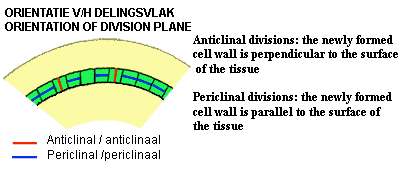 Periclinal: directional term referring (perhaps unexpectedly) to the radial direction. The image, from Virtual Classroom Biology (Radboud Univ. Nijmegen) makes more sense than any amount of explanation we could add. Another image we found very useful is here. However, that image is the from the incredible set of University of Hawaii Botany pages by Prof. David Webb. We have already so far exceeded our self-imposed quota of images from Prof. Webb's site, that we must leave it as a link.
Periclinal: directional term referring (perhaps unexpectedly) to the radial direction. The image, from Virtual Classroom Biology (Radboud Univ. Nijmegen) makes more sense than any amount of explanation we could add. Another image we found very useful is here. However, that image is the from the incredible set of University of Hawaii Botany pages by Prof. David Webb. We have already so far exceeded our self-imposed quota of images from Prof. Webb's site, that we must leave it as a link.
Perine: "The perine is the normal outer wall layer of the spores of homosporous ferns and lycopsids and is also found in the microspores of the Isoetaceae and Selaginellaceae. A distinct perine layer is present in mosses but is absent in liverworts, hornworts, and Coleochae." Kenrick & Crane (1997) (citation omitted).
Peristome: a combination of Greek roots roughly meaning "stuff around the mouth." In mosses, this means the ring of peristome teeth around the orifice of the spore capsule that control spore dispersal. See discussion of the moss sporophyte.
Petal: one of the whorls of a flower; petals may be brightly colored.
Phloem: conducting tissue of vascular plants. Phloem differs from xylem both structurally and functionally. Functionally, phloem transports solutes both up and down the plant, while xylem functions as a one-way transport system for moving water from the roots to the leaves (or equivalent). Phloem carries sugars and other direct or indirect products of photosynthesis to the stem and roots, generally during the day. Phloem also carries ions and soil nutrients up from the roots to the stem and leaves, generally at night. Xylem makes considerable use of the cell walls of dead or enucleated cells. Phloem uses living cells. Xylem uses capillary action and suction, like a straw, to transport water. Phloem uses osmotic pressure to move solutes. A high concentration of solute is loaded inside cells of the phloem at a source, such as a leaf where sugars are produced. This creates a diffusion gradient that draws water into the cells. The resulting pressure causes a flow to occur. If the dissolved sugars or other chemicals carried along with the sugars are removed from the phloem at another place in the tree for use (a sink such as a root or fruit), the decline in concentration of sugar causes water to move out of the phloem cells. Because water is moving in at a source and out at a sink, there is a mass flow of water and substances in the phloem. In trees, phloem is shed annually with the bark. Water and Chemical Movement Beneath the Bark
Phyllid: the leaf of a bryophyte. By many more exacting definitions, this does not constitute a leaf, hence the purported need for this apparently pointless addition to your vocabulary.
Phyllotaxy: the pattern in which leaves are arranged around a stem.
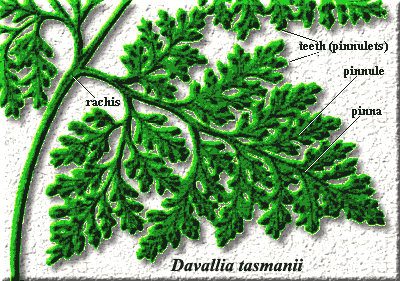 Pinna: first order of subdivision of a compound
leaf or fern frond. Davallia tasmanii image adapted from vonKonrat
et al. (1999).
Pinna: first order of subdivision of a compound
leaf or fern frond. Davallia tasmanii image adapted from vonKonrat
et al. (1999).
Pinnate: a type of leaf venation in which all of the veins of the leaf arise from a central mid-rib. Compare palmate, parallel-veined.
Pinnule: the second order of segments of a compound leaf or fern frond.
Pinnulet: as you have undoubtedly guessed, the third order of segments of a compound leaf or fern frond.
Pistil: the "female" organs (megagasporangium) of a flower, including the stigma, style, ovary, and ovule.
 Pit:
the thin, remnant primary wall of tracheids, i.e., primary wall
which has not been covered by lignified secondary wall. Pits are
involved in translocation of fluids from the xylem. See
also, pit membrane.
Pit:
the thin, remnant primary wall of tracheids, i.e., primary wall
which has not been covered by lignified secondary wall. Pits are
involved in translocation of fluids from the xylem. See
also, pit membrane.
Pit membrane: in many sources, the term pit refers to the absence of secondary wall, i.e. the "hole" in the secondary wall, while the primary wall is the pit membrane. The distinction becomes important in detailed xylem anatomy because vessels may have pits but usually lack pit membranes. In that case the pit is simply a hole in the vessel wall.
Pith: a central unspecialized parenchymous ground tissue in monocot roots and dicot stems.
Plagiotropic: plagiotropic growth of branches is growth at ≥ 90º to the direction of growth of the main axis (i.e. the branches grow directly outward or downward, in the usual case). Compare orthotropic. Huber & Hutchings (1997).
Plasmodesma: (pl. plasmodesmata) "Plasmodesmata are narrow channels that act as intercellular cytoplasmic bridges to facilitate communication and transport of materials between plant cells. The plasmodesmata ... are extremely specialized channels that allow for intercellular movement of water, various nutrients, and other molecules (including signalling molecules) ... . Plasmodesmata are located in narrow areas of cell walls called primary pit fields, and they are so dense in these areas (up to one million per square millimeter) that they make up one percent of the entire area of the cell wall." Plasmodesmata.
Plesiomorphic: a plesiomorphic character of a taxon is one which it shares with an ancestral group. It is not a unique, derived character (synapomorphy or apomorphy), but a primitive character which tells us nothing about its evolutionary position.
Pollen: the microspore of seed plants that contains the microgametophyte (male gametophyte)
Pollination: the transfer of pollen from the pollen organ to the ovule; for example in flowering plants from stamens to the stigmatic surface of the carpel.
Polystelic: having more than one stele.
Primary growth: growth in length, controlled by the apical meristem
Primary pinna: leaflet of first subdivision of a fern frond or compound leaf.
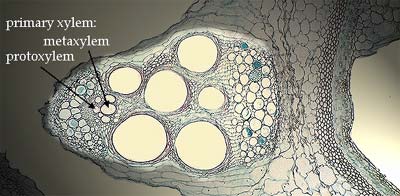 Primary xylem: xylem is found in leaves
and young stems or in young roots it is referred to as primary xylem.
Primary xylem is xylem derived from apical meristem,
rather than cambium. It contains fiber cells and tracheids
(pipe-like) elements which progressively develop secondary, lignified
walls until little of the primary wall is left except at pits.
These pits operate to permit fluids to move between tracheids. The precise
centrifugal series of secondary wall structures, and the shape and pattern of
mature pits are useful in taxonomic and forensic work.
Primary xylem: xylem is found in leaves
and young stems or in young roots it is referred to as primary xylem.
Primary xylem is xylem derived from apical meristem,
rather than cambium. It contains fiber cells and tracheids
(pipe-like) elements which progressively develop secondary, lignified
walls until little of the primary wall is left except at pits.
These pits operate to permit fluids to move between tracheids. The precise
centrifugal series of secondary wall structures, and the shape and pattern of
mature pits are useful in taxonomic and forensic work.
Propagule: in plants, a propagule is whatever structure functions to reproduce the species: a seed, spore, stem or root cutting, etc.
Protocorm: The cell mass formed during the earliest phase of germination. "The term protocorm was first proposed by Melchior Treub in 1890 to describe the early stages in the germination of lycopsids. Orchid protocorms resemble those of lycopsids — according to Bermard’s use of the term—and it has been used extensively (Arditti, 1992). Protocorms have round or elliptical shapes with some unicellular absorbing hairs on the basal part and an apex meristem on the tip." Chang et al. (2005).
Protonema: first growth from a germinating spore, especially, the thread-like process from a germinating moss (Bryophyta) spore.
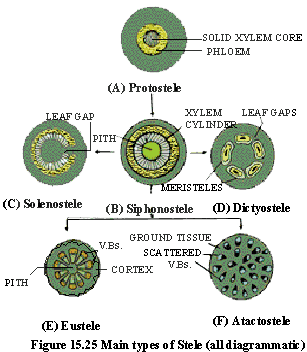 Protostele: a type of stele with a solid core of
primary xylem. Compare siphonostele. Image from the Pink Monkey site.
Protostele: a type of stele with a solid core of
primary xylem. Compare siphonostele. Image from the Pink Monkey site.
Protoxylem: the first xylem cells to develop. They are relatively small because the cells "stopped expanding while they – and all the surrounding internode tissues – were still young and close to the shoot apical meristem." Protoxylem.
Pseudomonopodial: a type of branching characterized by the presence of a main branch which has outgrown the other of the dichotomous pair, resulting in a main axis with smaller lateral branches. A type of branching where the apical meristem divides to form two branches, one of which is dominant resulting in an upright main axis with distinct side branches. Compare (and see fuller discussion at) monopodial, sympodial.
Pteridophyte: a paraphyletic group including (roughly) all Tracheophyta except Spermatophytata, i.e. rhyniophytes, lycophytes, ferns and horsetails. Plants which are tracheophytes, but not seed plants. The term has also been used more restrictively, to refer to leptosporangiate ferns, for example. Cantino et al. (2007)
Pychnoxylic: dense wood that contains little parenchyma; typical of Archeopteris, and conifers; compare to manoxylic.
Pyrenoid: a starch storage structure found in the chloroplasts of green algae.
-Q-
Quadriseriate: in four ranks or rows.
| Page Back | Page Top | Unit Home | Page Next |
ATW090605
Unless otherwise indicated, all text is public domain. No rights reserved.